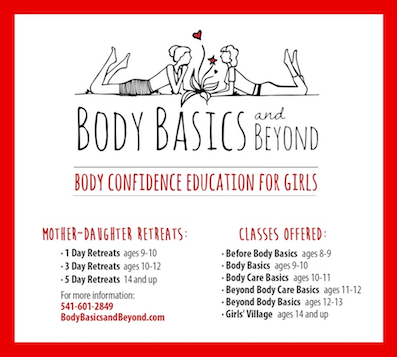Back To School Tips


 expectations will be. You should always know the people your child will be spending time. It does not matter if they are a child or an adult. Ask questions of those adults that are in charge. If it is an organized activity, ask about what kinds of supervision will be given to the participants.
expectations will be. You should always know the people your child will be spending time. It does not matter if they are a child or an adult. Ask questions of those adults that are in charge. If it is an organized activity, ask about what kinds of supervision will be given to the participants. know that you are involved in your child’s life and you are also letting them know that you will be watching for signs that indicate when something is not right. You are reducing the risk for your child to be abused!
know that you are involved in your child’s life and you are also letting them know that you will be watching for signs that indicate when something is not right. You are reducing the risk for your child to be abused!
 Remember your children are watching you and will take their cues from you. If you are enjoying the holidays, the frenzy, the time with family then chances are your children will as well. Our children mirror our behavior in a lot of ways. If you are unhappy and stressed out, they likely will be as well.
Remember your children are watching you and will take their cues from you. If you are enjoying the holidays, the frenzy, the time with family then chances are your children will as well. Our children mirror our behavior in a lot of ways. If you are unhappy and stressed out, they likely will be as well. The holidays are a time to spend with the ones you love doing the things you enjoy. Do not rob yourself of the joy by making it so frenzied you are too stressed out to remember the things you love about spending time with family and friends.
The holidays are a time to spend with the ones you love doing the things you enjoy. Do not rob yourself of the joy by making it so frenzied you are too stressed out to remember the things you love about spending time with family and friends.
As a parent one of the hardest things I have had to do was teach my child how to talk about feelings. The conversation was not hard but teaching the skill has been off the scale in terms of difficulty. The gift of being able to articulate what you feel and what you want is one of the most important things you can do for your child’s  emotional well-being.
emotional well-being.
There are some simple things you can do to help your child be successful in this endeavor. One thing you can do is to not discount whatever he tells you about what he is feeling.
For example if your child tells you that he is angry about something, do not tell him he should not be mad. Instead, ask him about what is making him angry. Help your child identify feelings and emotions by using facial expressions, feelings posters, or using books. There are some great books about emotions for even very young child that use facial expression. It is a great way to start the conversation and to start to identify what feelings look like and feel like.
Another way to teach a child about feelings and talking about feelings is to model that behavior for them. Talk about how you are feeling. Children learn behaviors and what is acceptable by watching the adults in their life. If you get in the habit of talking about your feelings in front of your child, then they too will begin to talk about feelings. Be appropriate when doing so as we all know what great imitators children can be. An example could be “I am feeling really happy today because you cleaned your room” or “I am sad because you are not feeling well today”.
Show empathy with your child. A good example might be “I can see you are feeling sad and disappointed that you will not be able to go to the park today because it is raining.” Of course help your child to practice this skill by listening to him and asking him questions about his day and how he is feeling.
 Be interested in what he has to say. This is such an important skill to teach. When children are frustrated because they cannot find the right words to express what they are feeling many times we will see anger, sadness and maybe a tantrum or two. This is a great excise that will allow you and your child to increase communication and social skills.
Be interested in what he has to say. This is such an important skill to teach. When children are frustrated because they cannot find the right words to express what they are feeling many times we will see anger, sadness and maybe a tantrum or two. This is a great excise that will allow you and your child to increase communication and social skills.

Cyberbullying – what parents should know
As parents it’s our job to help our children develop into independent, confident, and self-assured young adults. The pressures and complexities of being a teen, and being the parent of a teen, couldn’t be more challenging. It’s hard enough for kids to find their place in the physical world and try to fit in, but the cyber world has added a whole new layer of concerns.
Cyberbullying is bullying that takes place using digital technology. Cyberbullying most commonly involves the use of cell phones, but may also involve computers, tablets, iPods, gaming consoles and just about any device that connects to the “cyber” world. The actually bullying is facilitated through websites and applications such as Facebook, Instagram, Twitter, Tumblr, Snapchat, and Kik Messenger. Common examples of cyberbullying include mean and threatening text messages, rumors sent by email or posted on social networking sites, and embarrassing pictures, videos, websites, or fake profiles.
Twitter, Tumblr, Snapchat, and Kik Messenger. Common examples of cyberbullying include mean and threatening text messages, rumors sent by email or posted on social networking sites, and embarrassing pictures, videos, websites, or fake profiles.
Digital technology is not to blame for cyberbullying. In fact, digital technology and the power of the Internet have a very positive impact on learning, sharing of ideas, problem solving and staying appropriately connected with friends and family. But these tools can also be used to hurt other people. Whether done in person or through technology, the effects of bullying are the same. According to the US Department of Justice, kids who are bullied are more likely to use drugs and alcohol, have poor grades, skip school, have more health problems associated with the stress, avoid attending school, church, and social functions, and have lower self-esteem.
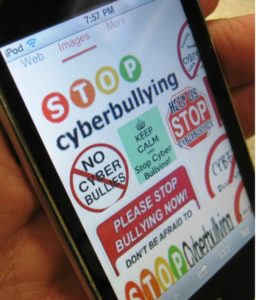 So what should you do as a parent to help reduce the risks of cyberbullying? The most important thing to do is talk with your kids about cyberbullying and other online issues regularly. You should also regularly look for opportunities to model and teach empathy. When we help our kids put themselves in another person’s shoes, they learn to be more sensitive to what that person is experiencing and are less likely to tease or bully them. By explicitly teaching our kids to be more conscious of other people’s feelings, we can create a more accepting and respectful community. Learn more at www.StopBullying.gov
So what should you do as a parent to help reduce the risks of cyberbullying? The most important thing to do is talk with your kids about cyberbullying and other online issues regularly. You should also regularly look for opportunities to model and teach empathy. When we help our kids put themselves in another person’s shoes, they learn to be more sensitive to what that person is experiencing and are less likely to tease or bully them. By explicitly teaching our kids to be more conscious of other people’s feelings, we can create a more accepting and respectful community. Learn more at www.StopBullying.gov

By Elycia Bechard, LPC
Therapist at The Children’s Advocacy Center of Jackson County
As families gather together for the holidays it can be a great opportunity to step back and remember the importance of connection. If you are fortunate enough to have positive memories from your childhood experience of family meals, try to remember how those moments of learning, connection, or modeled behaviors affected you or shaped who you are today. I frequently hear from parents their difficulties in trying to juggle their many responsibilities: children, partner, family, work, etc., so here are some fun, exciting ideas you can use while eating together as a family to develop or re-establish deeper connection with your child.
The goal is to get away from the TV and make dinner time fun for the whole family. If children choose not to participate, that is okay. Parents modeling smiling, laughing and having fun can motivate children to participate!
 ingredients at the grocery store as well as in the kitchen. This can be helpful for children with persnickety eating habits to feel a sense of control and value.
ingredients at the grocery store as well as in the kitchen. This can be helpful for children with persnickety eating habits to feel a sense of control and value.
A wonderful starting place is to sit down and figure out how often you could potentially incorporate one of these fun, new ideas into mealtime, and most importantly be consistent. If you can plan to do it once a week, once a month, or any other amount of time, that is terrific. Create a schedule where your children have something fun to look forward to. Overall, enjoy each other and have FUN!

Geocaching provides hours of free outdoor adventures for the whole family!
By Alex and Amanda Smith
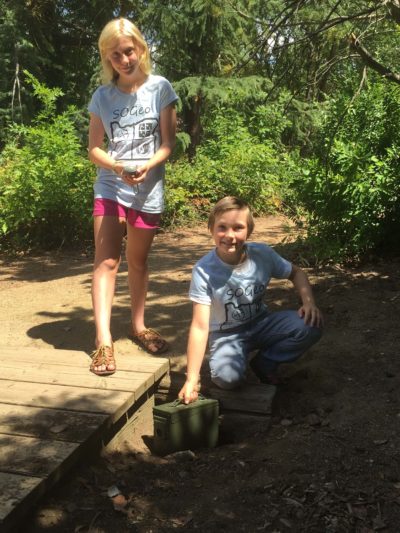 search
search 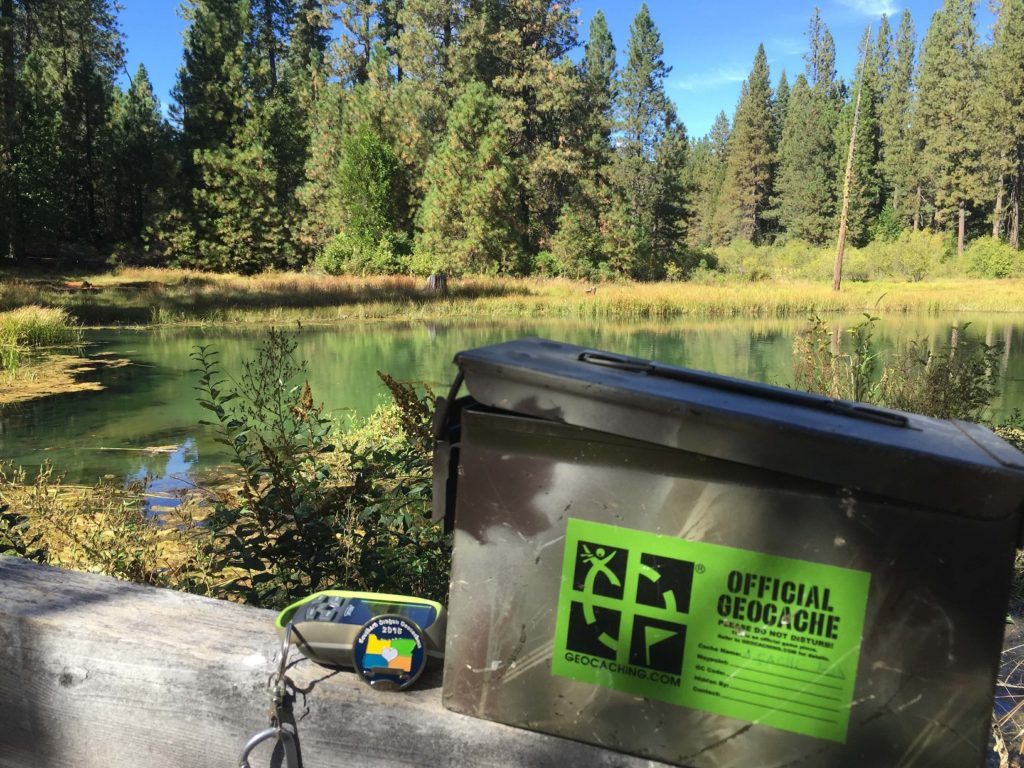 your home address and let the adventure begin! Each cache will have a description of what you are looking for and sometimes a hint. You can also read the past logs of other folks who have found that cache. Once you discover the physical cache you will find a log sheet to write your geocaching name on. Then you can log the find online via smart phone or computer and share your experience with other cachers. Often, inside the cache you will find small tradeable items so make sure you have a trinket if you want to swap something! This is a favorite part of the game for young cachers. See Geocaching.com for more details on tradable items.
your home address and let the adventure begin! Each cache will have a description of what you are looking for and sometimes a hint. You can also read the past logs of other folks who have found that cache. Once you discover the physical cache you will find a log sheet to write your geocaching name on. Then you can log the find online via smart phone or computer and share your experience with other cachers. Often, inside the cache you will find small tradeable items so make sure you have a trinket if you want to swap something! This is a favorite part of the game for young cachers. See Geocaching.com for more details on tradable items.
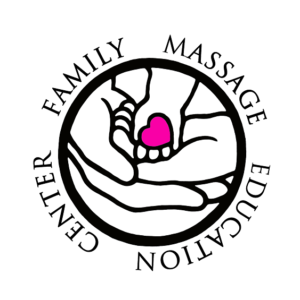 Infant Massage:Bonding and Benefits for Parents and Babies
Infant Massage:Bonding and Benefits for Parents and Babies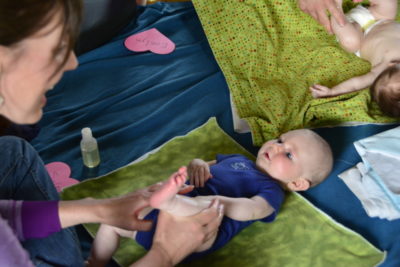 advantages of infant massage in
advantages of infant massage in  reducing colic, sleeping problems, and stress hormones. It is found to improve nerve coatings, digestion, brain development, muscle tone, immune function and much more…
reducing colic, sleeping problems, and stress hormones. It is found to improve nerve coatings, digestion, brain development, muscle tone, immune function and much more…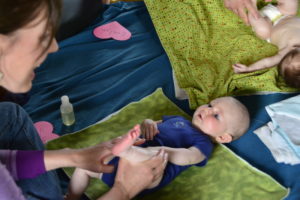 attention. This simple and strengthening nourishment of massage builds their confidence, their bodies, their trust in each other; setting a strong foundation for life!
attention. This simple and strengthening nourishment of massage builds their confidence, their bodies, their trust in each other; setting a strong foundation for life!
Pools, rivers, ponds, and beaches mean summer fun and cool relief from hot weather. But water also can be dangerous for kids if parents don’t take the proper precautions. Nearly 1,000 kids die each year by drowning, with

the majority happening in home swimming pools. It is the second leading cause of accidental death for people between the ages of 5 and 24.
The good news is there are many ways to keep your kids safe in the water – and make sure that they take the right precautions when they’re on their own.
Purchase proper-fitting, Coast Guard-approved flotation life vests and have kids wear them whenever near water. Check the weight and size recommendations on the label, then have your child try it on to make sure it fits snugly. For kids younger than 5 years old, choose a vest with a strap between the legs and head support – the collar will keep the child’s head up and face out of the water. Inflatable vests and arm devices such as water wings are not effective protection against drowning.
Fencing is your best measure of protection for a backyard pool or and should be at least 4 feet tall. Pool covers and alarms have not proven effective against drowning for very young children.

Above all else, supervise your kids at all times when around water – whether the water is in a bathtub, wading pool, fish pond, pool, spa, the beach, river or lake. Never assume because your child took swimming lessons or is using a flotation device that there is no drowning risk.
Water play can be a great source of fun and exercise. Teach your child that safety is a priority and that they never swim alone. And don’t forget the sunscreen!
Since 2007, Kohl’s Cares has awarded over $177,000 in grants to Asante for health focused outreach programs to the community.




Tween. Yes, that is exactly where she is. Wherever that is.
She is still a child, but she is finding a new voice and attitude that is unfamiliar.
“Geez, mom! What’s the big deal? I’ll be done in a minute…” (in a sassy tone). You cringe.
You say to yourself, “where did THAT come from?” Right out of the blue it seems. Then as if nothing happened she is back to happily re-organizing her stuffed animals alphabetically.
Welcome to the land of tween! There are a few things you should know to help you navigate your way through this new territory.
Your girl is likely unaware of her new behavior
If you ask her immediately after her reaction to your request to stop what she is doing and come to dinner, “where did that come from?” she will like say, “What? What do you mean?”
It is easy to think that she is putting you on…but she isn’t. This is as new for her as it is for you and she has no idea what is happening to her.
So don’t ask her why she is acting that way. She doesn’t know.
As parents, our “sassy” radar is always on in regards to our daughter’s behavior. Sassy = disrespectful, entitled, unappreciative. We don’t like it. None us want our girls to hold these characteristics. So when sassy shows up, we are quick to want to nip it in the bud.
“What did you just say to me?”
“How you said that is not okay. Use a nicer voice please”
And this is what is going through her head:
“Uh-oh, mom’s mad at me…what did I do now?”
“I am in trouble”
“I did use a nice voice…didn’t I?” now doubting herself.
Then come the tears. Her emotions erupt. As she runs out of the room and exclaims through her angry tears, “Why are you mad at me? I don’t get it! You are mean!” and she is gone.
What is going on?
Girls typically experience emotional latency between the ages of 6-11. This is a welcomed time of generally calmer emotions and emotional expression. She feels her emotions but not to the extreme that she may have felt and expressed them during the first five years of her life.
Then, as if over night, this emotional calm becomes a series of unpredictable storms. The first thing that comes to everyone’s mind is “Ohhh…it is hormones! That is what is causing her to act this way” Sure, she has some hormones pulsing through her in preparation for puberty, but that age-old excuse is not the cause.
It is her brain changing and other influences, not just her hormones.
We are learning so much about the teen/tween brain. Your girl’s brain is about to undergo a major overhaul that follows the pattern of growth and changes that took place in her brain while in the womb. That is big. Basically, she is going through a brain update. And if you have updated a Smartphone recently, you know how that can go.
The emotional centers of the brain during this overhaul are overly sensitive, hence the heightened emotional reactions that can flare up. The part of the brain that allows for rational thinking and exudes calm may not appear on the scene until the mid twenties. So basically she is wired for emotion and not reason during this time in her life.
As a matter of new-fact, the changes in her brain and the events in her life have a greater affect on her emotional moods than hormones.
So was that your parental sassy alarm that went of when she came back at you with some attitude, or was it more than that? Let’s check.
Did you feel a little emotional surge from somewhere distant but familiar? Maybe your heart was racing a little? What did you say back to her? “Watch that tone of voice when you talk to me”. Where did that threat come from? That is not the way you usually talk to her.
Your brain may be done forming but you may still have your own teen behavior response system lurking in deep places within you. That threat may have been what you heard from your parent in response to your teenage behavior.
We can subconsciously hold onto behaviors and responses to experiences in our lives for many years- from childhood and beyond. And if we have not done the work of opening them back up again and meeting them then releasing them directly, they have a way of popping back up again, thanks to a trigger…such as your daughter putting up an emotional flare.
And BAM! Back you go to your own teen-self.
What to do? Life has an amazing way of propping mirroring experiences up in front of us to give us the opportunity to look into ourselves more deeply. Maybe to heal a wound, or to help us see something of deep emotional value by opening up something within us that needs our attention.
Many times we may not take that opportunity but I encourage you to take it. Now. Don’t blow it off. Trust me. This won’t be the last teen trigger you will experience. Sex, drugs and rock and roll may be up ahead.
So do your work now.
Depending on the depth of your emotional experiences as you were going through adolescence will depend how much work there is to do. Only you know that if you are really willing to be honest with yourself. It may be that just some journaling around your adolescence is necessary. Or meeting with a trusted therapist or counselor can help you move the emotional landmines that may have been laid during your adolescence. I have had some mothers go back to their mothers and process that time. Wow. Now there is some work!
Whatever it takes.
Go back now and heal that time in your life so your daughter doesn’t have to do it for you.
You won’t regret it. It may be one of the hardest things to do but one of the greatest gifts to your relationship with your daughter. Do it.
The sooner you can separate your adolescent triggers from your daughter’s behaviors the easier it is going to be for you to avoid “getting hooked”.
What does getting hooked look like? You are hooked when you can’t let something go. When she has said or done something that has activated your emotional response system.
You are hooked when you react instead of respond.
Do a little fishing the next time you and your daughter have an interaction around something potentially triggering and watch yourself. Here is how:
If you are:
 Maybe we got it from our own mothers doing it to us. Maybe we think that pushing works because it has in the past when she was little. Somewhere we got the message that pushing works- that pushing fixes things, makes them better.
Maybe we got it from our own mothers doing it to us. Maybe we think that pushing works because it has in the past when she was little. Somewhere we got the message that pushing works- that pushing fixes things, makes them better.
If you haven’t noticed it already, pushing your daughter is going to stop working for you.
Which when something stops working we tend to do it more in order to try and understand why it isn’t working. Human nature. And the more we push, the harder she starts pushing back. She is a good student of you! And you now have a pushy mess.
As your daughter is going through this major reorganization of her brain, you need to “update” your patitude, or was it more than that? Let’s check.
Did you feel a little emotional surge from somewhere distant but familiar? Maybe your heart was racing a little? What did you say back to her? “Watch that tone of voice when you talk to me”. Where did that threat come from? That is not the way you usually talk to her.
Your brain may be done forming but you may still have your own teen behavior response system lurking in deep places within you. That threat may have been what you heard from your parent in response to your teenage behavior.
We can subconsciously hold onto behaviors and responses to experiences in our lives for many years- from childhood and beyond. And if we have not done the work of opening them back up again and meeting them then releasing them directly, they have a way of popping back up again, thanks to a trigger…such as your daughter putting up an emotional flare.
And BAM! Back you go to your own teen-self.
What to do? Life has an amazing way of propping mirroring experiences up in front of us to give us the opportunity to look into ourselves more deeply. Maybe to heal a wound, or to help us see something of deep emotional value by opening up something within us that needs our attention.
Many times we may not take that opportunity but I encourage you to take it. Now. Don’t blow it off. Trust me. This won’t be the last teen trigger you will experience. Sex, drugs and rock and roll may be up ahead.
So do your work now.
Depending on the depth of your emotional experiences as you were going through adolescence will depend how much work there is to do. Only you know that if you are really willing to be honest with yourself. It may be that just some journaling around your adolescence is necessary. Or meeting with a trusted therapist or counselor can help you move the emotional landmines that may have been laid during your adolescence. I have had some mothers go back to their mothers and process that time. Wow. Now there is some work!
Whatever it takes.
Go back now and heal that time in your life so your daughter doesn’t have to do it for you.
You won’t regret it. It may be one of the hardest things to do but one of the greatest gifts to your relationship with your daughter. Do it.
The sooner you can separate your adolescent triggers from your daughter’s behaviors the easier it is going to be for you to avoid “getting hooked”.
What does getting hooked look like? You are hooked when you can’t let something go. When she has said or done something that has activated your emotional response system.
You are hooked when you react instead of respond.
Do a little fishing the next time you and your daughter have an interaction around something potentially triggering and watch yourself. Here is how:
If you are:
 Maybe we got it from our own mothers doing it to us. Maybe we think that pushing works because it has in the past when she was little. Somewhere we got the message that pushing works- that pushing fixes things, makes them better.
Maybe we got it from our own mothers doing it to us. Maybe we think that pushing works because it has in the past when she was little. Somewhere we got the message that pushing works- that pushing fixes things, makes them better.
If you haven’t noticed it already, pushing your daughter is going to stop working for you.
Which when something stops working we tend to do it more in order to try and understand why it isn’t working. Human nature. And the more we push, the harder she starts pushing back. She is a good student of you! And you now have a pushy mess.
As your daughter is going through this major reorganization of her brain, you need to “update” your parenting tactics. You may need a complete overhaul or just to make a few adjustments.
Take a good long look at how you are parenting your daughter. Make a list of what is working and what isn’t working. Talk to other mothers with daughters to learn about what they are doing, or did. Read books. See a therapist. Be pro-active in updating your parenting to meet the needs of this evolving person whose foundations are shifting right before your eyes.
And get to know patience really well. It is your rock.
Patience is the foundation that holds up love, tolerance, empathy, and compassion in your mother and daughter relationship.
Practice it in other places in your life. It is alike a muscle that needs to be worked in order to be strong and reliable.
Make yourself stay in patience even when there is a storm raging around you- because your daughter is counting on you being strong…for both of you. Let her know that you are that rock. She will come to depend on it. So will you.
Seriously. It is important for us as mothers to focus on who she is and not be swept away by her behaviors- because that is what they are, just behaviors.
Be careful to not make her behaviors into who she is. She is so much more than how she acts.
Not only is it important for mother to know who she is…but she needs to know too…because she isn’t sure right now.
It can be a beautiful thing to help remind both of you who she is.
Make lists.
Then make a book for her…of her. Write her a letter with all of it in it. Create a bulletin board covered with her. Make a video of you telling her who she is.
It may sound corny to you but know this.
There is going to be a time when she comes to you emotionally disheveled and confused, not even sure what she wants from you. And you are going to be able to reach for that book, letter or video to remind her. And she will remember. You both will.
By Karen O’dougherty
